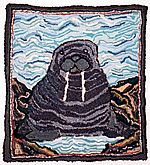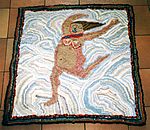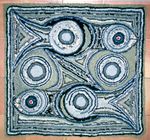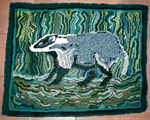![]()
by
Glenda Morris
Lewis says that he makes “fun rugs”. Rarely can he be induced to say more. I, however, have much to say about them. I have watched his entire development starting with Owl in 1998 through Streaky Bacon, Seagull, Mad March Hare, Frog with Red Worm, and Green Man to his latest, Polar Bear (number 51) and, by the time I finish revising this article, he will have completed another.
 |
|
Mad
March Hare
|
Lewis protested for twelve years, while watching his wife Louisa hooking rugs, that he could not take to this craft and then, suddenly he was away. Anyone who has eaten an (excellent) dinner he has prepared or been given his tour of (or some say march around) York would not be surprised that Lewis makes rugs in a big way and in his own way. I have heard him described as a “larger than life” character but I think it would be more accurate to say he enlarges the lives of others. So I expected his rugs be large and expansive, extravagant and free.
Instead they are precise and their construction orderly. The mizzy-mazzy backgrounds are not random, but systematic, and so his rugs have a unity and balance that often goes unnoticed. His system is to complete the main figure(s) and then work with one fabric: distributing it over the hessian. He goes on to the next, building up the background colour-by-colour or shade-by-shade. He is not rigid in his choice of colours nor tidy with his fabric (which roams freely about the room), and occasionally dips into his “studio”, a shocking jumble of inspiration. (His “studio”, by the way, is a large wicker basket.)
Where does he get his ideas, and how does he design and construct his rugs? I believe he makes whatever touches him into his own. For example, when he was thinking about Fish we were trolling though a second-hand shop looking for pots (he was a potter and is an expert on studio pottery) and a Japanese tray with a fish design fired his imagination. After Fish was completed, he gave me a plate decorated with a fish and said that was also his inspiration. I would never have guessed that either of these had had anything to do with his Fish. Objects (like a wooden Teddy Bear) or other people’s designs sometimes inspire him, but he never copies them slavishly.
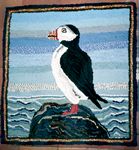
Puffin
His way of working is what one of my friends calls the “burst” theory of creativity. He sees the design in a burst and, thereupon progresses systemically and confidently to its end. I came to understand this process when he was working on the rug Throw My Ball? wherein a mongrel dog is appealing to the viewer. Lewis unhappily took someone else’s suggestion about the design and making the rug was a struggle. He had to work hard to make the dog a dog and not a rabbit, and attempted to soften the stark white of the bone in the foreground by adding a variegated pink, but this only made it into a bloody bone. I suppose he was feeling that way about the whole rug at the time, but it sickened me. Turning the “scraps of flesh” into a pink ball finally made the rug come out right, and now it is charming, but still not one of Lewis’s favourites.
Some people have to develop their designs as they go along; some people can copy other people’s designs; and some people can take up the suggestions of onlookers: not Lewis. He must work to his own design in his own way. So once he has the design, what next? He is confident of his ability to draw, so he uses a shorthand squaring-up system, marking an “X” in the centre of the hessian and drawing his design in chalk. Once he is satisfied with it, he marks it out in heavy black felt-tip so that he has a line to work to, putting in some indication of the background: perhaps squiggles, or ruling off a few diagonal lines. If he has a border, he marks that off with a ruler and outlining it in black rug wool keeps the straight edge. He makes his loops small and so his borders and outlines are precise.
Click on the images
to see a larger picture
Because Lewis is an experienced teacher and gives workshops (usually along with Louisa and myself), he has given some thought to encouraging and inspiring others. Participants sometimes claim that they cannot draw. Now anyone who can write his or her name can draw, but not everyone has the confidence, knowledge or experience to do a satisfactory (to them) drawing. Paperweights shows a way around this impasse. Lewis used a dinner-plate as a template to draw three-in-a-row by three-in-a-row circles, and filled in these with different designs to give a simple but effective demonstration that lack of skill in drawing need not be a hindrance.

Paperweights
One area where he does look for help is selecting the fabrics. He is, as many of you know, very fortunate to be married to Louisa. Now there are many reasons why one envies him for this, including her lively sense of humour and good company, but you rug-makers have an additional reason to envy him. For Louisa has a vast store of fabrics, and she is very generous with them. She is also willing to give advice. For example, when Lewis was hunting for fabric for A Clown Louisa held up a bright turquoise ball-gown in the charity-shop and said something like: “I think this would suit you”. What the other people in the shop thought, I don’t know, but heads turned. In Clown, Lewis used large areas of the same fabric to give a flat poster effect. (Usually he uses many fabrics, often closely related shades.)
In my view, Clown was the turning-point in Lewis’s attitude toward fabrics. He began to enjoy finding his own. When he started hooking rugs, he would use strips that had been pulled out of other people’s rugs because they were easier to work with. Now he has definite ideas about what he wants to use and often rejects my left-overs. He favours wool scarves in the borders, striped ones often producing complex effects.
Click on the images
to see a larger picture
Most of Lewis’s rugs are of a similar size (3 feet x 3 feet) and the majority have a central figure (usually an animal, but do not forget Mermaid, Awakening Angel, Discretion to the Winds). He has made many explorations in design, including Parrot Fish (an abstract in grays), A Study Window (with books, pot, and a view), Seaflower (a fantasy), and Hobbit Tree and Heart of the Woods (both of these were for the exhibition In Praise of Trees in Salisbury Cathedral). He is constantly experimenting within his own style, which he found very early on in his rug-making career.
For 25 years Lewis was the art master at Ashfold School near Aylesbury and, although he believes that you cannot teach art, he knows how to nurture creativity. He provided good materials and knowledge when he was teaching there, so the boys experimented with many arts and crafts, including weaving, tufted-rug making, pottery, glass engraving as well as drawing and painting. In addition, Lewis has experience both as a cartoonist and in making mosaics. All of these, I believe, influence his work and contribute to his precision in technique and whimsy in design.
Lewis does not stop at making, exhibiting and teaching about rag rugs. For years he has been collecting rug-making tools. His collection is large and unusual, including a silver button-hook and a latch-key converted into hooks, and some of his collection is in the American Museum in Bath. In addition, he pokerworks names onto rug hooks at workshops. His eye for design transforms these everyday objects into something special.
Click on the images
to see a larger picture
So, what do I conclude about Lewis’s psychology? He may not allow me to say this, but I believe that he follows the maxim he once burned into a wooden spoon for me: “Angels can fly because they take themselves so lightly”. The deep psychological and artistic meaning to his rugs is that they are fun rugs. They are fun for him to make; fun to be around when he is making them; and fun to live with.
© Glenda Morris
2003
If you would like to reproduce this article please contact Glenda at gbmorris@btopenworld.com
RUGS
:: LOUISA &
RAG RUGS :: LEWIS & RAG RUGS :: CONTACT
CREDITS & LINKS :: HOME :: RUGS AVAILABLE FOR SALE
Louisa
Creed
York, UK, 2001-2023
